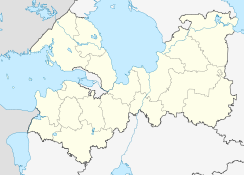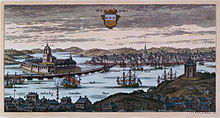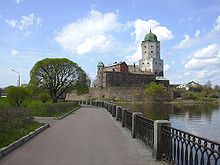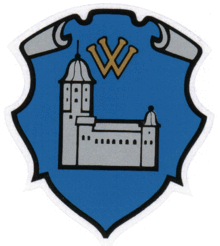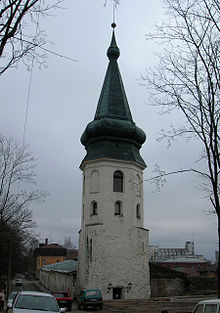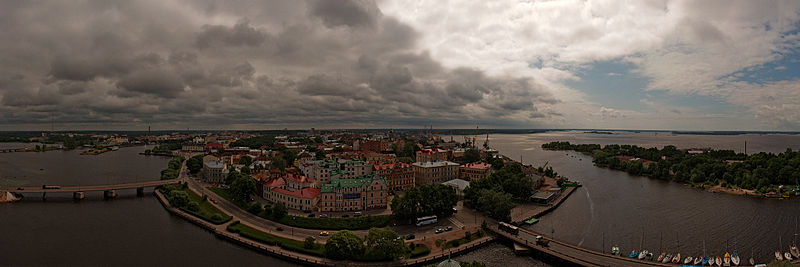- Vyborg
-
Vyborg (English)
Выборг (Russian)- Town[citation needed] - 
A view of Vyborg from the castle tower.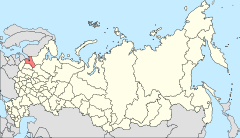
Location of Leningrad Oblast in RussiaCoordinates: 60°42′23″N 28°44′39″E / 60.70639°N 28.74417°ECoordinates: 60°42′23″N 28°44′39″E / 60.70639°N 28.74417°E Coat of arms Flag Administrative status Country Russia Federal subject Leningrad Oblast Administrative center of Vyborgsky District[citation needed] Municipal status Head[citation needed] Vasily Osipov[citation needed] Representative body City Council of Deputies[citation needed] Statistics Area 112.27 km2 (43.35 sq mi)[citation needed] Population (2010 Census,
preliminary)80,013 inhabitants[1] - Rank in 2010 207th Population (2002 Census) 79,224 inhabitants[2] - Rank in 2002 202nd Density 713 /km2 (1,850 /sq mi)[3] Time zone MSD (UTC+04:00)[4] Founded 1293[5] Postal code(s) 188800–188811[citation needed] Dialing code(s) +7 81378[citation needed] Official website Vyborg (Russian: Вы́борг; Finnish: Viipuri; Swedish: Viborg; German: Wiborg; Estonian: Viiburi) is a town in Leningrad Oblast, Russia, situated on the Karelian Isthmus near the head of the Bay of Vyborg, 130 kilometers (81 mi) to the northwest of St. Petersburg and 38 kilometers (24 mi) south from Russia's border with Finland, where the Saimaa Canal enters the Gulf of Finland. Population: 80,013 (2010 Census preliminary results);[1] 79,224 (2002 Census);[2] 80,924 (1989 Census).[6]
The Hanseatic city lies in the boundary zone between the East Slavic/Russian and Finnish/Scandinavian worlds and has changed hands several times in history, most recently in 1944 when it was retaken by the Soviet Union from Finland during World War II.
Contents
History
The area where Vyborg is located used to be a trading center on the Vuoksi River's western branch, which has dried up. The area was inhabited by the Karelians, a Finnish tribe which gradually came under the domination of Novgorod and Sweden.
According to Russian archaeologist V. Tyulenev, a wooden Karelian fort was already in existence there during the 11th and 12th centuries.[citation needed]
The first castle of Vyborg was founded during the so-called "Third Swedish Crusade" in 1293 by marshal Torkel Knutsson. The castle was fought over for decades between Sweden and the Republic of Novgorod. By the Treaty of Nöteborg in 1323, Vyborg was finally recognized as a part of Sweden. It withstood a prolonged siege by Daniil Shchenya during the Russo–Swedish War of 1496–1499.
The town's trade privileges were chartered by the Pan-Scandinavian King Eric of Pomerania in 1403.
Under Swedish rule, Vyborg was closely associated with the noble family of Bååt, originally from Småland. The late-medieval commanders and fief holders of Vyborg were (almost always) descended from or married to the Bååt Family; in practice they functioned as Margraves (though not having this as their formal title), having feudal privileges and keeping all the crown's incomes from the fief to use for the defense of the realm's eastern border.
Vyborg remained in Swedish hands until its capture after the Siege of Vyborg by Emperor Peter the Great in the Great Northern War (1710). The Treaty of Nystad (1721), which concluded the war, assigned the town and a part of Old Finland to Russia.
One of the largest naval battles in history, the Battle of Vyborg Bay in 1790, was fought off shore in the Viipuri Bay on July 4, 1790.
After the rest of Finland was ceded to Russia in 1809, Emperor Alexander I of Russia incorporated the town and its province into the newly-created Grand Duchy of Finland in 1812.
In the course of the 19th century, the town developed as the center of administration and trade for the eastern part of Finland. The inauguration of the Saimaa Canal in 1856 benefited the local economy as it opened the vast waterways of Eastern Finland to the sea. Viipuri was never a major industrial center, and lacked large production facilities, but due to its location it served as a focal point of transports of all industries on the Karelian Isthmus, Ladoga Karelia and South-Eastern Finland.
Following the Russian Revolution of 1917 and the fall of the Russian Empire, Finland declared itself independent. During the Finnish Civil War Viipuri was in the hands of the Finnish Red Guards until it was captured by the White Guard on 29 April 1918.
In the inter-war decades, the town, then officially known as Viipuri, was the second biggest city in Finland and center of Viipuri province. In 1939 Viipuri had some 80,000 inhabitants, including sizable minorities of Swedes, Germans, Russians, Gypsies, Tatars and Jews. During this time, Alvar Aalto built a masterpiece of modernist architecture — the Viipuri Library.
During the Winter War between the Soviet Union and Finland (1939-1940), more than 70,000 people were evacuated from Viipuri to western Finland. The Winter War was concluded by the Peace of Moscow, which stipulated the transfer of Viipuri and the whole Karelian Isthmus– emptied of their residents– to Soviet control, where it was incorporated in to the Karelo-Finnish SSR on March 31, 1940. As the town was still held by the Finns, the remaining Finnish population, some 10,000 people, had to be evacuated in haste before the handover. Thus, practically the whole population of Finnish Viipuri was resettled elsewhere in Finland.
The evacuees from Finnish Karelia came to be a vociferous political force and their wish to return to their homes was an important motive when Finland sought support from Germany against the Soviet threat. As a result, Finland and Germany fought on the same side in the Continuation War.
On August 29, 1941, Viipuri was recaptured by Finnish troops and, soon after, the Government of Finland formally annexed it along with the other areas lost in the Moscow Peace Treaty. At first the Finnish Army did not allow civilians into the town. Of the 6,287 buildings, 3,807 had been destroyed. The first civilians started to arrive at the end of September and by the end of the year Viipuri had a population of about 9,700. By 1942, it had risen to 16,000. About 70% of the evacuees from Finnish Karelia returned after the re-conquest to rebuild their looted homes, but were again evacuated after the Red Army's Fourth strategic offensive, timed to coincide with the Battle of Normandy. By the time of the Soviet offensive, the town had a population of nearly 28,000. The town was evacuated by June 19 and the defence of Viipuri was entrusted to the 20th Brigade. The town fell to the Red Army on 20 June 1944, but the Finns managed to halt the Soviet offensive at the Battle of Tali-Ihantala, the largest battle fought by any of the Nordic countries, in Viipuri rural municipality which surrounded the city.
In the subsequent Moscow Armistice of September 19, 1944, Finland returned to the borders set by the Moscow Peace treaty and ceded more land than the treaty originally demanded. In the 1947 Paris Peace treaties, Finland relinquished all claims to Viipuri.
After the Winter War, Leningrad had wanted to incorporate the area of Viipuri, but it took until September 1944 for it to be finally transferred from the Karelo-Finnish SSR to Leningrad Oblast.[7] During the Soviet era, the town was settled by people from all over the Soviet Union. The naval air bases of Pribilovo and Veshchevo were built nearby.
Economy
Vyborg continues to be an important industrial producer of paper. Tourism is increasingly important, and the Russian film festival Window to Europe takes place in the town each year.
An HVDC back-to-back facility for the exchange of electricity between the Russian and Finnish power grid was completed near Vyborg in 1982. It consists of three bipolar HVDC back-to-back schemes with an operating voltage of 85 kV and a maximum transmission rate of 355 megawatts, so that the entire maximum transmission rate amounts to 1420 megawatts.[citation needed]
Sights
Vyborg's most prominent landmark is the Swedish built castle, started in the 13th century and extensively reconstructed in 1891–1894. The Round Tower and the Rathaus Tower date from the mid-16th century. The Viipuri Library by Finnish architect Alvar Aalto is a reference point in the history of modern architecture.
There are also Russian fortifications, completed by 1740, as well as the monuments to Peter I (1910) and Torkel Knutsson. Tourists are shown the "Lenin house", where the Russian revolutionary prepared the Bolshevik revolution during his stay in Viipuri in September–October 1917.
Sprawling along the heights adjacent to the Gulf of Finland is Mon Repos, one of the most spacious English parks in Eastern Europe. The park was laid out on behest of its owner, Baron Ludwig Heinrich von Nikolay, at the turn of the 19th century. Most of the garden structures were designed by the architect Giuseppe Antonio Martinelli. Previously, the estate belonged to the future king Frederick I of Württemberg (Maria Fyodorovna's brother), who called it Charlottendahl in honor of his second wife.
International relations
Twin towns/sister cities
Vyborg is twinned with:
References
- ^ a b Федеральная служба государственной статистики (Federal State Statistics Service) (2011). "Предварительные итоги Всероссийской переписи населения 2010 года (Preliminary results of the 2010 All-Russian Population Census)" (in Russian). Всероссийская перепись населения 2010 года (All-Russia Population Census of 2010). Federal State Statistics Service. http://www.perepis-2010.ru/results_of_the_census/results-inform.php. Retrieved 2011-04-25.
- ^ a b Федеральная служба государственной статистики (Federal State Statistics Service) (2004-05-21). "Численность населения России, субъектов Российской Федерации в составе федеральных округов, районов, городских поселений, сельских населённых пунктов – районных центров и сельских населённых пунктов с населением 3 тысячи и более человек (Population of Russia, its federal districts, federal subjects, districts, urban localities, rural localities—administrative centers, and rural localities with population of over 3,000)" (in Russian). Всероссийская перепись населения 2002 года (All-Russia Population Census of 2002). Federal State Statistics Service. http://www.perepis2002.ru/ct/doc/1_TOM_01_04.xls. Retrieved 2010-03-23.
- ^ The value of density was calculated automatically by dividing the 2010 Census population by the area specified in the infobox. Please note that this value may not be accurate as the area specified in the infobox does not necessarily correspond to the area of the entity proper or is reported for the same year as the population.
- ^ Правительство Российской Федерации. Постановление №725 от 31 августа 2011 г. «О составе территорий, образующих каждую часовую зону, и порядке исчисления времени в часовых зонах, а также о признании утратившими силу отдельных Постановлений Правительства Российской Федерации». Вступил в силу по истечении 7 дней после дня официального опубликования. Опубликован: "Российская Газета", №197, 6 сентября 2011 г. (Government of the Russian Federation. Resolution #725 of August 31, 2011 On the Composition of the Territories Included into Each Time Zone and on the Procedures of Timekeeping in the Time Zones, as Well as on Abrogation of Several Resolutions of the Government of the Russian Federation. Effective as of after 7 days following the day of the official publication).
- ^ Энциклопедия Города России. Moscow: Большая Российская Энциклопедия. 2003. pp. 95. ISBN 5-7107-7399-9.
- ^ "Всесоюзная перепись населения 1989 г. Численность наличного населения союзных и автономных республик, автономных областей и округов, краёв, областей, районов, городских поселений и сёл-райцентров. (All Union Population Census of 1989. Present population of union and autonomous republics, autonomous oblasts and okrugs, krais, oblasts, districts, urban settlements, and villages serving as district administrative centers.)" (in Russian). Всесоюзная перепись населения 1989 года (All-Union Population Census of 1989). Demoscope Weekly (website of the Institute of Demographics of the State University—Higher School of Economics. 1989. http://demoscope.ru/weekly/ssp/rus89_reg.php. Retrieved 2010-03-23.
- ^ Dan Moody (30 March 2011). "Vyborg -The city with the most ancient European feel in Russia". Travel Russia. The Voice of Russia. http://english.ruvr.ru/radio_broadcast/36563396/48183328.html. Retrieved 4 November 2011.
External links
Cities and towns in Leningrad Oblast Administrative center: Saint Petersburg (administratively separate)  Boksitogorsk · Gatchina · Ivangorod · Kamennogorsk · Kingisepp · Kirishi · Kirovsk · Kommunar · Lodeynoye Pole · Luga · Lyuban · Nikolskoye · Novaya Ladoga · Otradnoye · Pikalyovo · Podporozhye · Primorsk · Priozersk · Sertolovo · Slantsy · Sosnovy Bor · Svetogorsk · Shlisselburg · Syasstroy · Tikhvin · Tosno · Volosovo · Volkhov · Vsevolozhsk · Vyborg · Vysotsk
Boksitogorsk · Gatchina · Ivangorod · Kamennogorsk · Kingisepp · Kirishi · Kirovsk · Kommunar · Lodeynoye Pole · Luga · Lyuban · Nikolskoye · Novaya Ladoga · Otradnoye · Pikalyovo · Podporozhye · Primorsk · Priozersk · Sertolovo · Slantsy · Sosnovy Bor · Svetogorsk · Shlisselburg · Syasstroy · Tikhvin · Tosno · Volosovo · Volkhov · Vsevolozhsk · Vyborg · Vysotsk
Major fortresses of Western Russia  Categories:
Categories:- Cities and towns in Leningrad Oblast
- Vyborg
- Forts in Russia
- Castles in Russia
- Karelian Isthmus
- Cities of Military Glory
Wikimedia Foundation. 2010.

